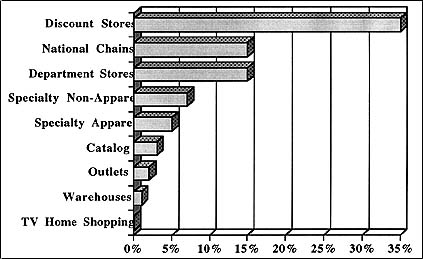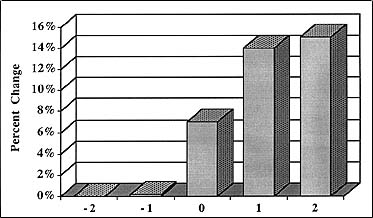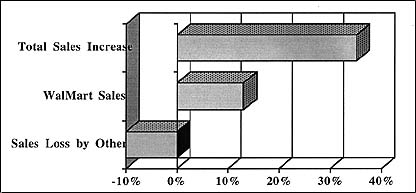
And it represents a major shift in the shopping habits of "middle America." Shoppers are using the major discount department stores as their primary retail centers. A recent survey of shoppers indicated most consumers plan to spend more of their holiday dollars at discount stores than anywhere else.

As WalMart Executive Vice President Nick White stated, "We believe that the opportunities are fantastic and endless."2 As successful as the company has been with their 80,000 to 120,000 sq. ft. marts, they are now upping the ante with the construction of new SuperCenters. These stores will include a full-service grocery store, a tactic which Meijers introduced many years ago in Michigan, and which is now catching on with the other large discounters. As White says, "We think we'll be able to grow this particular operation into the future indefinitely. The biggest challenge we have is our own ability to move as quickly as we would like to. Thus far, we have been able to more than double our supercenters each year over the past four years."3
The SuperCenter approach means that WalMart, and other discounters adopting the concept, will provide truly one-stop shopping for not just local, but regional, shoppers. The long-standing retail theory that people will not shop for both food and clothing in the same trip has been proven false in this new environment, and shoppers come to the large stores more as an "event" than as a needed chore. Shopping frequency is now often two or three times a week, and the projected market radius to such centers is up to 40 miles. This means that the traditional supermarket may be on the way out. At a recent company conference in Memphis, where it competes head-to-head with WalMart, Kroger company officials said to "...pity the third- and fourth-ranking food retailers in a town where a WalMart supercenter opens up. They will not survive. The first and second will be hit hard."4 What impresses the large food chain managers is WalMart's ability to provide products at a lower cost. Their distribution system technology is state-of-the-art, and the resulting advantage for the consumer of a full selection and lower cost is thus far an unbeatable combination.
The long-term impact of WalMart is less clear. Some downtown businesses in cities where WalMarts have located have benefited from the greater draw of customers. Others have been devastated by the overwhelming new competition for their customers' dollars. In a study of the impact of 14 WalMarts in Iowa, Kenneth Stone found positive impact in towns where WalMart had located. However, there was clearly a negative impact on other towns in the surrounding area; towns within a 20-mile radius of the WalMart stores saw total retail sales drop an average of 25 percent after five years.6
A study by Gruidl and Kline (1992) of Illinois towns indicated that the infusion of a large discounter store in a community dramatically increased the retail market area and draw for that particular town. As shown in the graph below, there was minimal growth in the two years preceding the opening of WalMart stores, but the years following show increases of 14 to 15 percent almost immediately. It may be assumed that WalMart's market analysts consciously looked for sites where there was already economic growth, but it is more likely that locating a new WalMart store in a community generated the resulting economic growth.

Yet this increase is deceiving, for the total includes growth from WalMart sales. When WalMart's sales are separated out, a different story is revealed. The chart below shows the impact on host towns, and illustrates that the gain in sales of general merchandise is divided unevenly between a significant gain for WalMart, but a loss for other local businesses.

The question of the impact of the WalMart "invasion" on smaller cities and their local retailers has been a major concern in downtowns throughout Michigan. Merchants in Cadillac directly tie the downtown's vacancies with the arrival of WalMart in the early 1990s. The small retailers who have moved out to the new malls on the city fringe generally have done well, while those who have stayed downtown have suffered. However, one downtown businessman said the problem is "small-mindedness;" merchants must recognize new customer markets, and not try to compete directly with WalMart. A small retailer in Lapeer said she couldn't buy goods wholesale for what WalMart was selling them retail.
In contrast, a local official in Howell< Michigan indicated WalMart's impact hasn't been that great, for the downtown's upscale specialty stores have kept a niche separate and apart from the products carried by the large discounters. One specialty shop merchant said WalMart has actually helped their business by drawing shoppers in from a larger area. A new business owner didn't feel the threat, for he saw WalMart and KMart catering to elderly customers, while downtowns are still appealing to younger customers.
In South Haven, the responses to the WalMart have been mixed. Some have felt the new store almost killed the downtown, with vacancies going as high as 20 percent while businesses adjusted to a new retail mix. But a local official indicated the downtown had always had a poor mix of stores, and WalMart actually filled a large void in the regional retail mix.
Sam Walton responded to the concerns of small-city retailers who criticized the WalMart strategies as being unfair and destructive to traditional downtowns in this way:
Quite a few smaller stores have gone out of business during the time of WalMart's growth. Some people have tried to turn it into this big controversy, sort of a "Save the Small Town Merchants" deal, like they were whales or whooping cranes or something that has the right to be protected.Of all the notions I've heard about WalMart, none has ever baffled me more than this idea that we are somehow the enemy of small-town America. Nothing could be further form the truth: WalMart has actually kept quite a number of small towns from becoming extinct by saving literally billions of dollars for the people who live in them, as well as by creating hundreds of thousands of jobs in our stores. I believe millions of people are better off today than they would have been if WalMart had never existed.
I don't want to be too critical of small-town merchants, but the truth is that a lot of these folks just weren't doing a very good job of taking care of their customers. Whenever we put a WalMart store into a town, customers would just flock to us from the variety stores. With our low prices, we ended an era of 45% markups and limited selection. We shut the door on variety-store thinking.7
1 Source: Deloitte & Touche.
2 Jay L. Johnson. Discount Merchandiser. April 1994. p. 38.
3 Ibid. p. 38.
4 Ibid. p. 38.
5 Edward O. Welles. "When Wal-Mart Comes to Town." INC. July 1993. p. 78.
6 Ibid. p. 78.
7 "Sam Walton Recounts the Life of a Salesman." TIME. June 15, 1992. p. 59.
| Kenneth Stone Study of Wal-Mart | Strategies to cope with Wal-Mart |
|---|
|
Case Study: Wal-Mart in Carroll, Iowa |
Impact of Wal-Mart in Michigan |
|---|
| Competition from Malls |
|---|
